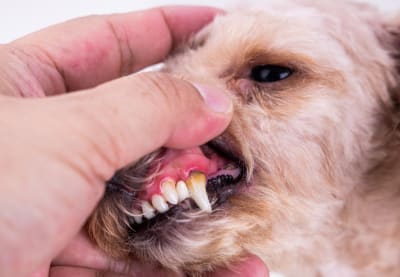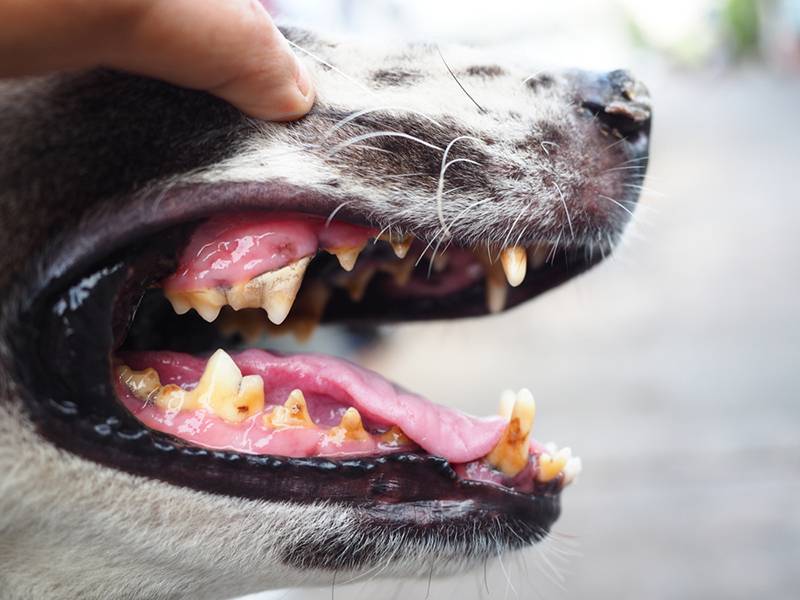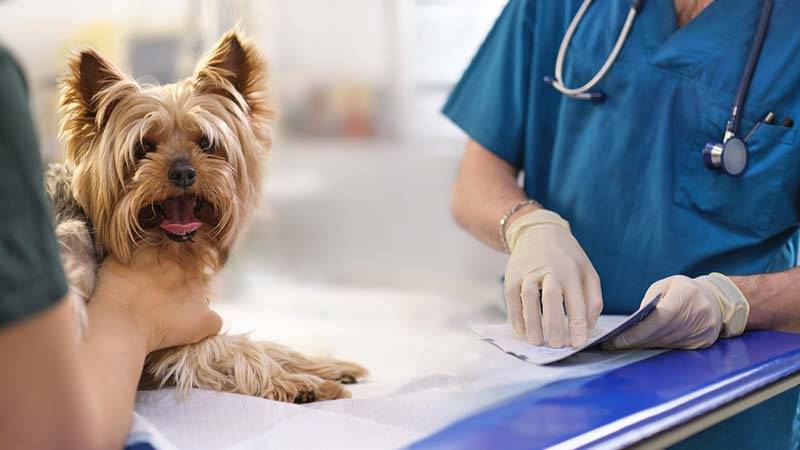
Gingivitis (gum inflammation) in dogs
Contents
Gingivitis in Dogs Essentials
Gingivitis in dogs is manifested by reddening of the gums, an unpleasant odor from the mouth, and pain when eating solid food.
The most common cause is dental disease. Less common are viral, fungal, autoimmune and other causes.
Most often, gingivitis occurs in a chronic form with a slow progression of the disease.
Treatment is aimed at eliminating the infection, healing of damaged tissues.
Gingivitis symptoms
In most cases, the disease develops gradually and has no acute clinical signs. At first, only the dog’s red gums can be noted. There should be no other changes in general well-being. Further, with progression, the gums may become painful, the dog will begin to eat worse, become more picky in food. She will be especially wary of dry food, as it injures the gums more. You can see how the dog approaches the bowl of food, sits bent over it, but does not eat. When the gums are injured, the dog may squeal. Due to malnutrition, the pet will lose weight.
The main visible symptoms of gingivitis include the following:
red border on the gums on the border with the teeth;
swelling and swelling of the gums;
bleeding gums;
salivation;
a large amount of dark yellow or brown plaque on the teeth;
unpleasant specific or purulent smell from the mouth;
purulent discharge in the area of the teeth and gums.

Photo of gingivitis in dogs
Gingivitis classification
There is no precise classification of gum disease in dogs. We can conditionally distinguish the following types of gingivitis.
Acute gingivitis
It is characterized by an acute onset of symptoms, a sharp deterioration in the condition of the animal, refusal to eat, high fever. It is most likely that in such a situation it will be necessary to look for the root cause that caused poor health. First of all, you need to pay attention to the viral causes.
Chronic gingivitis
Most cases of gingivitis occur in a chronic form. Clinical manifestations are most often limited to reddening of the gums, moderate soreness, and an unpleasant odor. The well-being of the pet should not be significantly changed.
Localized gingivitis
The localized form is characterized by the occurrence of inflammation only on a small limited area of the gum surface, most often due to trauma or tooth disease.
Generalized gingivitis
It manifests itself as inflammation of the entire surface of the gums in a dog. You can notice redness, swelling and swelling in all parts of the oral cavity. Often looks like a red border around the edge of the teeth.
Hypertrophic gingivitis
It is characterized by excessive growth of gum tissue. The gums can significantly cover the teeth. It should be differentiated from dysplastic gingival hypertrophy in some dog breeds. For example, boxers.
What factors accompany development?
Diseases of the teeth and gums are most often found in older dogs. Small breed dogs are also prone to dental problems, with serious changes occurring even at a very young age. Viral and autoimmune diseases can affect an animal of any age.
Periodontal diseases
The most common cause of gum disease in dogs is periodontal disease. Miniature dog breeds are more prone to this, such as the Yorkshire Terrier, Toy Poodle, Toy Terrier, Miniature Spitz, Chihuahua and others. Medium and large dog breeds get sick less often or only in old age. The accumulation of plaque on the teeth contributes to the increased reproduction of bacteria. Bacteria destroy the tissues of the teeth and gums, cause ulceration and purulent discharge. Plaque eventually turns into massive tartar, which also injures the gums and causes them to become inflamed.

Injuries
Many dogs are big fans of chewing on various hard objects. The most favorite are sticks, some also get bones. A hard, sharp surface of an object can injure the gum. Pieces of sticks and bones often get stuck in the gums and between the teeth, causing constant inflammation and pain. In this area, bacteria begin to multiply intensively, a purulent lesion occurs. After an injury, you can almost immediately notice that the dog’s gums are swollen and reddened, blood may flow.
Chemical substances
The ingestion of chemicals, such as acids and alkalis, into the cavity of the dog’s mouth also inevitably causes inflammation. Treatment should begin immediately with abundant washing of the affected tissues.
Viral diseases
Quite often in young dogs you can find a disease such as viral papillomatosis. It is characterized by damage to the gums (sometimes also the tongue, pharynx and even skin) and the formation of characteristic growths in the form of cauliflower. Against this background, the development of inflammation is likely. The disease is benign and can pass without treatment within 3 months, sometimes with significant growths, surgical removal is required.
Infectious hepatitis and canine distemper are also diseases of which gingivitis may be one of the symptoms. Viruses infect epithelial cells, gum tissue can also be involved in the process. But gum damage is only part of a generalized process, so treatment should first of all be directed to the entire body.
Fungal diseases
They are quite rare, more common in the Americas. Candidiasis is caused by the fungus Candida albicans and affects the oral cavity, including the gums. It is more common in immunocompromised dogs and in animals taking long-term immunosuppressive drugs. It usually appears as irregularly shaped ulcers surrounded by inflammation. Aspergillosis is another type of fungus that usually affects the respiratory tract of the animal, but can also descend into the cavity of the mouth, which will be manifested by inflammation of the gums in the dog.
Autoimmune diseases
Diseases such as pemphigus vulgaris and bullous pemphigoid most often have generalized symptoms. But one of their signs may be gingivitis. Diseases are caused by the body’s own immune system. For some reason, immune cells begin to consider epithelial tissues as foreign and attack them. There are inflammations, ulcers, erosions, including on the gums of the dog.
Acute necrotizing ulcerative gingivitis
Severe gingivitis is extremely rare. It is manifested by inflammation of the gums, up to the death of tissues. The bacteria Fusibacterium fusiformis or spirochetes (Borellia spp.) are thought to be the cause. Otherwise, the disease is little studied.
Other systemic diseases
Various systemic diseases of the body can secondarily lead to the occurrence of gingivitis. One of the most common diseases is kidney failure. As a result, uremia occurs in most cases. Uremia leads to inflamed gums in dogs, and ulceration of the cheeks and tongue. It is assumed that its cause is the breakdown of blood urea in these areas.
Diabetes can also lead to gingivitis. The exact mechanism is not known, but it is believed that this is due to a decrease in the flow rate of saliva and a change in its chemical composition. Ulcers in the oral cavity are difficult to treat, as diabetes mellitus leads to poor healing of all tissues.
Neoplasms of the oral cavity
Quite often, a tumor is found on the gums in dogs – a volumetric formation of tissues. Most often, this formation is epulis – a benign growth of gum tissue. Epulis can lead to inflammation of the gums, but in most cases, gingivitis, on the contrary, occurs earlier. Many cases of malignant formations in the oral cavity have also been described (for example, squamous cell carcinoma, fibrosarcoma, etc.). They are manifested by inflammation of the gums in a dog, soreness in the mouth area. Treatment consists in removal of the tumor, its histological verification. The next step is likely to be chemotherapy.
Diagnostics
In most cases, the fact that the dog has inflamed gums, the owners notice on their own at home. You can notice an unpleasant smell from the mouth, reddening of the gums, sometimes there is a clear soreness during feeding. At the doctor’s appointment, a visual examination is enough to make a preliminary diagnosis of gingivitis. But more research may be needed to identify the root cause. If a viral nature is suspected, PCR is taken or ELISA is performed. If a fungal pathogen is suspected, it will be necessary to take a smear from the lesions for a cultural study, that is, sowing. Diagnosing autoimmune diseases in most cases is difficult, since there are no specific tests for them, and histological examination of damaged tissues may be required. If a systemic disease is suspected, the pet will be given a general clinical and biochemical blood test, and an abdominal ultrasound will be recommended. If you suspect diabetes mellitus, you will need to measure the level of glucose in the blood and urine. But in most cases, the cause of gingivitis is still periodontal disease. To understand which teeth are damaged and what is happening to them, an x-ray of the teeth is taken, in severe cases, computed tomography may be recommended.
Treating Gingivitis in Dogs
For the correct approach to the treatment of gingivitis in a dog, it is necessary to find the cause that caused it. This may require additional testing as described in the Diagnosis section. If the diagnosis has already been established, the doctor will prescribe the necessary procedures and drugs.
Veterinary help
If inflammation of the gums is detected, treatment will be required in any case. At first, gum disease in a dog does not look like something dangerous, but over time it will progress, the pet will experience constant pain. In advanced cases, the infection can lead to resorption of the jaw bones. Also, do not forget that chronic inflammation is a prerequisite for the appearance of cancerous tumors. In most cases, gum disease in dogs will be treated with ultrasonic tartar cleaning. According to the rules, this procedure can only be carried out under anesthesia, otherwise it is impossible to ensure the necessary quality of cleaning. Plaque and tartar is found on the entire surface of the tooth, even under the gum. The dog simply cannot endure calmly because of fear and pain, there is a high risk of dislocation of the joints from rough fixation. All decayed teeth must be removed, otherwise recurrence is inevitable. After cleaning, teeth are polished to smooth the surface and less plaque sticks in the future. If extensive inflammation and pus is found during a cleansing, antibiotics may be recommended. If an infectious or autoimmune cause is identified, treatment will focus on addressing that problem first. Sometimes it can only be brought under control, but not completely cured.
At home
In the initial stages, the treatment of gingivitis can be done at home on your own, but you will probably still need to visit a doctor. If you find a slight reddening of the gums, you can start washing with a solution of Chlorhexidine or Miramistin, a decoction of chamomile is also suitable – they will partially help remove the infection. If the gum is bleeding, you can use a decoction of oak bark, it has astringent properties and will temporarily help stop the bleeding. To rinse your dog’s mouth:
Draw up the required solution into the syringe. It is better to prepare more solution, as there is a chance that some of it will end up on the floor in the process of fighting a frightened pet.
Tilt the dog’s head down and open its mouth.
Direct the jet of solution at the teeth and gums, but so that the solution does not fall into the throat, but flows down. All of the proposed solutions will not cause any problems if they enter the stomach, but under strong pressure, the dog may accidentally inhale the liquid, which can enter the lungs.
Rinse all surfaces of the teeth and gums, paying special attention to the affected areas.
Diet
During treatment, the dog will need to change their usual diet. Solid foods will irritate the gums, cause pain, and prevent lesions from healing. You should either switch to ready-made wet feeding, or start pre-soaking dry food in warm water so that it softens to a pulp. When feeding a natural diet, all hard and large pieces must be crushed or boiled. Gnawing on bones, sticks and other things must be strictly excluded.
Prevention of gingivitis
The best prevention is regular brushing of teeth with a special veterinary brush and paste. Such a procedure must be started from puppyhood at least once every 1 days. Brushing your teeth helps to remove plaque along with the infection in a timely manner and prevents it from growing into massive tartar. Prevention of viral diseases comes down to annual comprehensive vaccination, it includes protection, including against viral hepatitis and canine distemper. Unfortunately, there is no prevention of autoimmune processes and oncology. Annual clinical examination can help to avoid the development of systemic diseases.
Answers to frequently asked questions
October 24 2021
Updated: October 26, 2021







